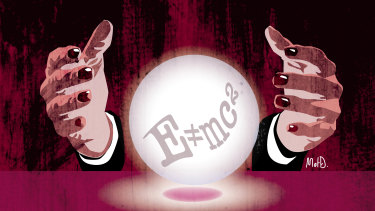Look closely and the RBA’s upbeat forecasts for the economy aren’t that wonderful
Although everyone knows it’s impossible to know what the future holds, everyone – from prime ministers to punters – asks economists to forecast what will happen to the economy. The economists always oblige. The latest set of official forecasts for our economy were laid before us by the Reserve Bank on Friday. You beaut. Now all is known.
Though economists have an appalling forecasting record, we are undeterred in asking for more, and the economists are undeterred in providing them.

Psychologists tell us people to suffer from “the illusion of control” – the tendency to overestimate their ability to control events. Once we know what’s going to happen, we can duck and weave accordingly.
Maybe economists keep producing their forecasts merely to be obliging, but I suspect they suffer their own illusion: that having a dodgy forecast is better than not having any.
Particularly at times when we’re trying to recover from a recession – recessions the economists rarely if ever saw coming – Reserve Bank governors produce optimistic forecasts, or try to sound upbeat about a not-so-wonderful forecast, for the justifiable reason that what actually happens can, to some extent, be influenced by what enough people expect to happen. People tend to act on their expectations, as part of their illusion of control.
If ever there was proof that we live in an age of “radical uncertainty” – where we must make decisions (or forecasts) on utterly insufficient information – the past year must surely be it.
Reserve governor Dr Philip Lowe sounded very upbeat about his latest forecasts but, when you examine them closely, they’re not all that wonderful. Funny thing is, most of his optimism was based on the recession being not nearly as bad as he was forecasting throughout most of last year.
If he was conscious of the irony of sounding confident about this year’s forecast because last year’s had been so wrong, he did a good job of concealing it.
He’s certainly right in saying the economy bounced back after the easing of the initial lockdown far earlier and more strongly than anyone expected – with the possible exception of Scott Morrison, who was no doubt praying for another miracle.
If ever there was proof that we live in an age of “radical uncertainty” – where we must make decisions (or forecasts) on utterly insufficient information – the past year must surely be it.
The three after-the-fact reasons Lowe gave for being so wrong – we did a better job of suppressing the virus than expected; the government applied a lot more budgetary stimulus than expected; and businesses and households adapted their behaviour in unexpected ways to minimise the economic cost of the lockdown – are a useful checklist of what could go wrong with this year’s forecast of above-trend growth in real gross domestic product of 3.5 per cent in calendar 2021 and a further 3.5 per cent in 2022.
Such a seemingly optimistic prediction could prove just as wrong as last year’s – though in the opposite direction – if something goes wrong with the rollout of the vaccines or our containment of the virus, if the government’s imminent termination of its main stimulus measures proves premature, or if the behaviour of businesses and households is less helpful than the forecasters have assumed.
I suspect that most of the improvement in the economy’s rate of growth is improvement that’s already happened. It’s the bounce-back from the lifting of the lockdown, not the start of a sustainably strong recovery.
By about the middle of this year, the rapid bounce-back will have run its course, and the recovery proper will begin at a much weaker rate. If so, those two years of seemingly way-above-trend annual growth will look better than they really are, being partly an arithmetic illusion caused by our obsession with rates of change rather than the levels of GDP. The arithmetic catching up with the reality.
What forces will be driving the economy onward and upward? Not population growth, not a lower dollar, not a roaring world economy, not healthy business investment. Consumer spending is forecast to be strong, but it won’t get that strength from the forecast growth in real wages of a mere 0.25 per cent a year for the next two and a half years.
Nor will spending be powered by further budgetary stimulus. With the end of the JobKeeper wage subsidy and maybe the JobSeeker supplement in March, stimulus is being cut. No, if consumer spending stays strong it will be because stimulus payments made but not spent last year will be spent this year. Maybe. Maybe not.
But the ultimate proof that Lowe is not as optimistic as he appears is in his confident prediction that the Reserve won’t need to consider raising interest rates until 2024 at the earliest. Why? Because “wages growth and inflation are both forecast to remain subdued”. If so, the future won’t be all that wonderful.
Ross Gittins is the Herald’s economics editor.
Money with Jess newsletter
Practical tips and information you can trust from senior writer Jessica Irvine to help you budget, earn, invest and enjoy your money. Sign up to get it every Sunday.
Ross Gittins is the Economics Editor of The Sydney Morning Herald.
Most Viewed in Business
Source: Thanks smh.com